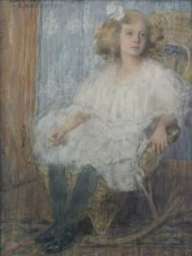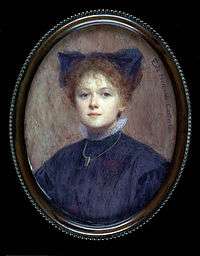Eda Nemoede Casterton
Eda Nemoede Casterton (April 14, 1877 – November 15, 1969) was an American painter known specifically for her portrait miniatures in watercolor, pastels and oil. She exhibited works at the Paris Salon and the San Francisco Panama–Pacific International Exposition of 1915, among others. Her works are at the Smithsonian American Art Museum and the Brooklyn Museum.
Eda Nemoede Casterton | |
|---|---|
| Born | Eda Nemoede April 14, 1877 |
| Died | November 15, 1969 (aged 92) |
| Nationality | American |
| Education | School of the Art Institute of Chicago |
| Known for | Painting |
Early life
Eda Wilhelmina Nemoede was born in Brillion, Wisconsin on April 14, 1877[1] to Edward Carl Ludwig Nemoede, a harnessmaker, and Maria Georgina Bastian[2][3] of German ancestry.[4] They had 11 children, eight of whom reached adulthood.[5] Her siblings were Bertha, 16 years her senior; Agnes; Rudolph; Anna; Hattie; Herman;[2] and Alma Caroline.[6]
Against the wishes of her teacher and family, she painted on the walls of her schoolhouse as a young girl. She wanted to become an artist. According to her parents wishes, she studied to become a stenographer[7] and then worked for attorney Peter Martineau as a secretary.[4][8] Following the death of her father March 6, 1895 in Oconto, Wisconsin,[3] Casterton lived in Chicago with her mother and her sisters Hattie and Alma Caroline and worked as a stenographer.[6]
Education


Nemoede studied at the Minnesota[11] or Minneapolis School of Fine Arts.[12] When she worked as a stenographer, she spent her lunch hours at the School of the Art Institute of Chicago,[4][7] where she studied with Virginia Richmond Reynolds, considered the most accomplished miniature American painter of the time.[13] Of painting miniatures, Casterton said that they were "small paintings painted in a big way."[4]
After she began working as an artist,[4] she took more classes and completed commissioned works of art with her teacher.[7] In France, Casterton studied with Henry Salem Hubbell[4][13] and exhibited her works at the Paris Salon, where she received an honorable mention in 1905.[4][10]
Career
[[File:Eda Nemoede Casterton - Elizabeth Kennedy - Shown at 1918 Chicago Society of Miniature Painters Exhibition.jpg|thumb|200px|Eda Nemoede Casterton, Elizabeth Kennedy, miniature portrait, black and white photograph, Shown at 1918 Chicago Society of Miniature Painters Exhibition, Art Institute of Chicago]]
Artist and instructor
She began by painting watercolor on thin sheets of ivory,[14] like the portraits Miss Goss and Little Girl.[10][15] An article in the Chicago Chronicle, dated June 21, 1903, stated, "Eda Nemoede bids fair to become one of the greatest miniature painters of America and those who have seen her work praise it unstintingly."[16] Her work was described, "Each is a well-realized, strongly modeled, carefully detailed portrait. They were praised for their poetic evocation of mood as well as fidelity to physical likeness. The skin tones are clear and delicate" in the article When Small is Big.[4]
She enjoyed painting children, having said "I want to paint children in the sunshine, young girls out of doors with the wind in their hair and the sky's deep blue in their eyes."[4]
She exhibited several portraits and was on the Art Committee for the annual Art Institute of Chicago in 1907.[17][18] Casterton returned from Paris in 1908 and began teaching at the Art Institute of Chicago.[19]

After she married, Casterton created works of art in oil or pastels, as well as watercolor miniatures.[20] In 1913, she exhibited a portrait of her daughter, Jane, at the annual Art Institute of Chicago exhibition.[21] She exhibited Mae Olson (1906) at the City Art Museum of St. Louis in 1916.[22] She exhibited four miniature portraits at the 1918 exhibition for the Chicago Society of Miniature Painters, including Elizabeth Kennedy.[23]
Even as miniature paintings become less popular, she was a successful artist and received international recognition. She began making full-size portraits in the 1920s, including having patterned a work after a U.S. Army lieutenant made during Thomas Jefferson's presidency.[4] She exhibited her works in solo and group exhibitions.[11][24]
Her works are held by the Smithsonian Institution,[15] The Brooklyn Museum[9] and The John H. Vanderpoel Art Association.[11]
Recognition and memberships
Casterton received Honorable Mention at the International Art Union (Paris) in 1907 and 1908, was awarded a Silver Medal at the Panama-Pacific International Exposition of 1915,[7][25] and a Bronze medal at the Sesqui-Centennial Exposition at Philadelphia of 1926.[7]
Casterton was a member of the American Society of Miniature Painters,[26] British Royal Society of Miniature Painters,[10] Royal Society of Miniature Painters, and the Pennsylvania Societies of Miniature Painters.[14] In 1914 she was the vice president of the Chicago Societies of Miniature Painters.[27] Between 1949 and 1951 she received awards at the League of the American Pen Women Exhibitions.[11]
Personal life
In 1910, Casterton worked in Chicago as an artist and supported her mother and nieces, Eda L. and Alta V. Nemoede.[5]
On June 29, 1911, Eda Nemoede married William John Casterton in Chicago.[28] Their first daughter, Jane was born in 1912.[29] Her mother, Mary Nemoede, died on December 8, 1914.[3] Their second daughter, Virginia was born in February 1917.[29] Casterton was a Christian Scientist.[4]
William Casterton died February 9, 1948 in Evanston, Illinois.[30] In 1952, she moved to Missoula, Montana where she worked as an artist and lived with her sister.[31] She died November 15, 1969, at Palos Verdes Estates, California, at 92 years of age.[20]
References
- American Art Annual. MacMillan Company; 1913. p. 232.
- 1880 census, Clintonville, Wisconsin. Tenth Census of the United States, 1880. (NARA microfilm publication T9, 1,454 rolls). Records of the Bureau of the Census, Record Group 29. National Archives, Washington, D.C.
- Edward Nemoede (January 20, 1838, Germany - March 6, 1895, Oconto County) and Mary Bastian Nemoede (October 25, 1837, Germany - December 8, 1914, Chicago, Illinois.) Evergreen Cemetery, Oconto, Oconto County, Wisconsin. Retrieved March 19, 2014.
- "When small is big". Christian Science Monitor. 1984. Retrieved March 19, 2014.
- Eda W Ncemoede [sic]. 1910 Census, Chicago, Illinois. Thirteenth Census of the United States, 1910 (NARA microfilm publication T624, 1,178 rolls). Records of the Bureau of the Census, Record Group 29. National Archives, Washington, D.C. For details on the contents of the film numbers, visit the following NARA web page: NARA
- Eda Nemoede. Chicago Ward 30, Cook, Illinois. United States of America, Bureau of the Census. Twelfth Census of the United States, 1900. Washington, D.C.: National Archives and Records Administration, 1900. T623, 1854 rolls
- Eda Nemode Casterton. Smithsonian American Art Museum. Retrieved March 18, 2014.
- George E. Hall. A history of Oconto, Wisconsin. Oconto Pub. Corp.; 1969. p. 113.
- 'Mae Olson' by Eda Nemoede Casterton. Boston Museum of Art. Retrieved March 18, 2014.
- Miss Goss. Smithsonian American Art Collection. Retrieved March 18. 2014.
- Eda Nemoede Casterton. Illinois Women Artists. Retrieved March 18, 2014.
- American Art Directory. R.R. Bowker.; 1918. p. 564.
- San Francisco Panama-Pacific International Exposition. 1915. Dept. of Fine Arts. Official Catalogue of the Department of Fine Arts, Panama-Pacific International Exposition (with Awards) San Francisco, California. Wahlgreen Company; 1915. p. 126.
- "Miniatures of Many Prominent Appleton Women to be Exhibited." Appleton, Wisconsin: Appleton Post Crescent. November 27, 1926. p. 9.
- 'Little Girl' by Eda Nemoede Casterton. Smithsonian American Art Museum, 3rd Floor, Luce Foundation Center. Retrieved March 18, 2014.
- "Eda Nemoede". Chicago Chronicle. June 21, 1903.
- Art Institute of Chicago. Annual American Exhibition [of] Water Colors and Drawings. 1907. pp. 145, 163.
- Bulletin of the Art Institute of Chicago. The Institute; 1907. p. 49.
- Mae Olson, biography of Eda Nemoeda Casterton. Brooklyn Museum of Art. Retrieved March 18. 2014.
- Eda Nemoede Casterton (1877 - 1969). The Museum of Wisconsin Art. Retrieved March 18, 2014.
- Exhibition of Works by Artists of Chicago and Vicinity. Art Institute of Chicago; 1913. p. 15.
- City Art Museum of St. Louis. Special Exhibition Catalogue. 1916. p. 118.
- Catalogue of the 1918 Chicago Society of Miniature Painters. Art Institute of Chicago. Retrieved March 19, 2014.
- 29th Exhibit of The Milwaukee Journal's Gallery of Wisconsin Art, 1930. Museum of Wisconsin Art. Retrieved March 18, 2014.
- John E.D. Trask. Catalogue de luxe of the Department of Fine Arts, Panama-Pacific International Exposition" . San Francisco: Paul Edler & Company, assessed from Archive.org. Retrieved March 18, 2014.
- American Art Directory. R.R. Bowker.; 1914. p. 203.
- American Art Directory. R.R. Bowker.; 1914. p. 98.
- William J. Casterton and Eda Nemoede on June 29, 1911. "Illinois, Cook County Marriages, 1871–1920." Index. FamilySearch, Salt Lake City, Utah, 2010. Illinois Department of Public Health records. "Marriage Records, 1871–present." Division of Vital Records, Springfield, Illinois.
- 1920 census for Downers Grove, DuPage, Illinois. Fourteenth Census of the United States, 1920. (NARA microfilm publication T625, 2076 rolls). Records of the Bureau of the Census, Record Group 29. National Archives, Washington, D.C. For details on the contents of the film numbers, visit the following NARA web page: NARA. Note: Enumeration Districts 819-839 are on roll 323 (Chicago City).
- William J. Casterton. Illinois Death Certificates Database, 1916–1950. Illinois State Archives. Retrieved March 18, 2014.
- "Two Talented Artists Exhibit at MIA Shop Here." Helena, Montana: The Independent Record. August 25, 1955. p. 3.